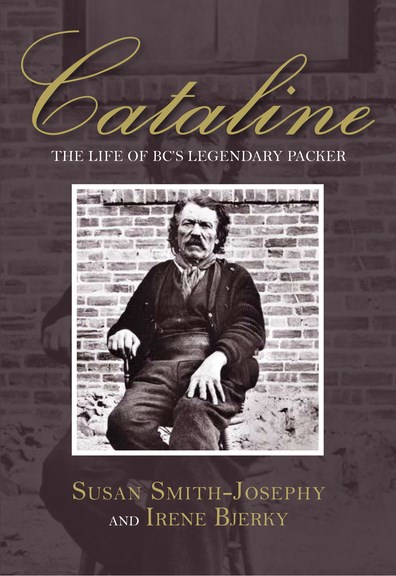From a motel in Fraser Lake to a statue in New Hazelton to an elementary school in Williams Lake, it's only a matter of time before you come across the name Cataline in northern B.C.
It was the nickname of Jean Caux, a man of folkloric stature in B.C.'s history. From the 1850s to the early 1900s, pack trains were often the only viable mode of commercial transport across B.C.'s Interior and Catiline was perhaps the most noted provider of the service.
Tall, broad and forceful, with a penchant for starting every trip wearing a brand-new white shirt, a habit of rubbing whiskey into his hair and able to make himself understood despite speaking in a garbled mix of dialects, if you met him, you'd never forget him.
It was on the basis of this outsized personality that Quesnel-based author and history buff Susan Smith-Josephy has written the book Cataline: The Life of B.C.'s Legendary Packer (Caitlin Press, 184 pages, $22.95).
That nothing of the sort appears to have been produced in the nearly 100 years since his death comes a surprise to Smith-Josephy but she has been reaping the reward - her work has held a place on the B.C. Book Publisher Association's bestseller list for 15 weeks.
"It's just a little local history book about a guy that I was interested in but I guess he struck a chord with people ever since he became known," Smith-Josephy said in an interview. "Maybe that chord is still out there somewhere. People are still interested in him."
What Smith-Josephy lacked in journals and other traditional types of record for research, she made up for in accounts gathered from newspapers and magazines, anecdotes gleaned from archived interviews and photos and receipts - tonnes of receipts - dug up in museums and historic sites around the province. (A photo dated 1913 of Cataline on a horse found at Exploration Place takes a prominent place in the book).
Smith-Josephy also gave a shout out to Irene Bjerky. An apparent descendant of Cataline's first wife, Bjerky was instrumental in gathering what she could on the man and is listed as a co-author.
"It was awesome to have someone so enthusiastic about Cataline...She loved Cataline too, so it spurred me on to finish it," Smith-Josephy said.
As much as the book is about Cataline, it's also about a particular time in the province's economic history. Smith-Josephy provides a fascinating account of how the business of packing worked, from the prices and tolls charged for goods carried and services rendered to the sweat and toil both man and animal endured.
Mules were preferred over horses because they could carry more - as much as 227 kilograms (500 pounds) - and would end up with anything on their backs from basic food stuffs to billiard tables to, in the case of a particularly tough and ornery mule, an electric light plant for a gold mining operation on Manson Creek.
Days would start at two in the morning, when the weather was cool, and the trains would cover as much as 50 kilometres (30 miles) in a day.
"It was hard work," Smith-Josephy said. "It was brutal on the animals. It was also brutal on the people."
A rarity in the trade, Cataline ran his trains for more than 50 years and developed a reputation for reliability and for a remarkable ability to keep track of accounts and agreements on memory alone.
He also relied on an unorthodox system to finance his trips. Each spring he would set up a line of credit and then leave it to his customers to pay his creditors or ask his creditors to pay his bills for him. "For the most part, they did so, although over the years his trusting nature did cost him a great deal of money," Smith-Josephy writes in the book.
Cataline lived out most of his last days in Hazelton, living in a cabin built by a fellow packer who also bought his pack train. Far from rich in money, Cataline remained rich in other ways.
"He had friends everywhere and everyone spoke well of him," Smith-Josephy said.
It's the second book Smith-Josephy has written. It follows on the 2011 publication of Lillian Alling: The Journey Home, about a woman determined to return to her home in Europe by making her way overland from New York to Alaska and across the Bering Sea.
Smith-Josephy said similarities between Cataline and Alling have been pointed out to her. Both were immigrants (Cataline was born in France) who crossed incredible distances over the courses of their lives and weren't famous in the traditional sense.
"They were regular working class people and they made an impact on peoples' memory," Smith-Josephy said.
Alling's story has become the stuff of legend and even an opera that premiered in Vancouver in 2010. Whether the same will be said of Cataline remains to be seen but in the meantime Smith-Josephy has completed the first draft of a book about a gang of bank robbers whose holdup of the Union Bank in New Hazelton in 1914 descended into a hail of bullets.
"Shootout at New Hazelton, there were so many articles about that, but I wanted to find out more about these robbers," she said. "What were they doing, why were they doing it and what happened to them afterwards?"



